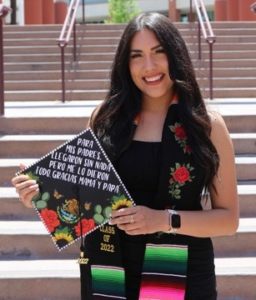 As a junior at Esteban E. Torres High School in East Los Angeles, Melisa Osuna didn’t know what to expect from her first college experience, a Chicano Studies dual enrollment class offered by East Los Angeles College. What she discovered was a welcoming, engaging classroom experience that got her excited about college and boosted her confidence to pursue other opportunities like internships. Melisa, a first-generation college student, is now a new graduate with a degree in social work from Cal State University Los Angeles. And she is looking forward to a career in the public school system, giving back to the community. (Read Melisa’s story.)
As a junior at Esteban E. Torres High School in East Los Angeles, Melisa Osuna didn’t know what to expect from her first college experience, a Chicano Studies dual enrollment class offered by East Los Angeles College. What she discovered was a welcoming, engaging classroom experience that got her excited about college and boosted her confidence to pursue other opportunities like internships. Melisa, a first-generation college student, is now a new graduate with a degree in social work from Cal State University Los Angeles. And she is looking forward to a career in the public school system, giving back to the community. (Read Melisa’s story.)
Such positive first encounters with college classes don’t happen by accident. Deliberate choices by the partnering institutions, East Los Angeles College and Los Angeles Unified School District, put structures in place to support student success in dual enrollment. In Melisa’s case, her college class was scheduled during regular school hours, located at her high school, and included other classmates. The professor created a supportive classroom environment in terms of pedagogical approach and class policies. This combination of factors—location, time, approach, and flexibility—helped create an engaging first college experience for students.
These features characterize “high school-only” types of dual enrollment such as College and Career Access Pathways (CCAP). Originally conceived to provide dual enrollment opportunities to students who are underrepresented in higher education, CCAP is a way of structuring dual enrollment that allows partnerships to offer courses on a high school campus along with other advantages such as the ability to limit courses to high school students only, a higher college credit limit, and higher priority enrollment. The state’s recent investment of $200 million to expand dual enrollment through CCAP and middle college or early college high schools affirms the importance of this approach.
Download the dual enrollment student profile of Melisa.
Access more dual enrollment resources including student voice profiles, videos, and audiograms.